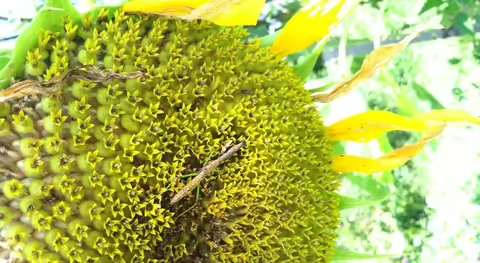
Nothing says summer like a brightly blooming sunflower (Helianthus annus). Often considered a weed in a farmer's field, many homeowners find joy filling their landscape and gardens with these majestic giants. The colorful, sunny blooms elevate a garden display and double as a snack for you and your garden wildlife.
Once a common crop among Native American tribes, sunflowers are now grown for their ornamental and commercial value. Certain kinds of sunflowers are grown as food (for both humans and animals), seeds, and oil. Sunflowers are also common additions to fresh floral arrangements or wedding bouquets.
How to grow sunflowers
The large, yellow blooms are made up of hundreds of tiny flowers, called florets. The yellow petals that surround the head are not truly petals, but specialized leaves designed to protect the center florets from pests or harsh weather. Sunflower blooms can range in color; cream, orange, red, maroon, light pink, and bicolor are newer colors to watch for in the garden centers and seed catalogs.
Although it is true, sunflowers are named for tracking the sun’s position in the sky, this only occurs in young plants. As flower buds develop, they may follow the daily path of the sun across the sky, but once they are mature, the stem hardens with flowers always facing east.
Sun and soil: This tough annual plant grows best in the full sun and in any soil that is not waterlogged.
Planting: They are easy to establish in a garden by direct seeding in the ground each spring.
Size: A fast-growing plant, sunflowers reach heights of 1 to 8 feet tall in the warm growing season, depending on the cultivar.
Harvest: Most sunflower varieties reach maturity within 70 to 100 days of planting. To harvest the seed heads before critters eat them, cut off the head once the back side is yellow-brown and the head is drooping down. Place it in a warm, dry place for a few weeks until it has dried. Enjoy roasting the sunflower seeds, sharing them with the wildlife, or saving seeds to plant next year.
One cool trait of the sunflower is their ability to inhibit the growth of nearby plants, a trait called allelopathy. The sunflower hulls contain a toxin that can prevent turfgrass and other plants from growing in that area. To prevent bare patches in lawn, clear dropped hulls from below birdfeeders and dried sunflower plants.
Pollinators and wildlife love sunflowers
While in full bloom, many pollinators will visit the flowers, including bees, beetles, and butterflies. As seed heads dry, even more Central Illinois wildlife visit for a snack. It is a great sight to view the colorful bird species that visit dried seed heads for a feast, and comical to witness pesky squirrels wrestling stems to the ground in hopes of a taste. Rabbits, voles, mice, chipmunks, and raccoons are also likely to snack on these treat-filled blooms.
Photo credit: Liz Repplinger, University of Illinois Extension. A brown praying mantis on a yellow sunflower.
ABOUT THE AUTHOR: Brittnay Haag is a Horticulture Educator with University of Illinois Extension, serving Livingston, McLean, and Woodford Counties. Her work focuses on youth horticulture education, specifically through school gardens and Jr. Master Gardener programs. Brittnay provides leadership for three county Master Gardener programs and is responsible for developing community programs and providing expertise in horticulture and environmental sciences.
